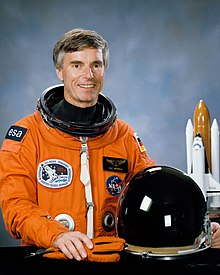
Back أولف ميربولد Arabic اولف ميربولد ARZ Улф Мерболд Bulgarian Ulf Merbold Czech Ulf Merbold German Ulf Merbold Esperanto Ulf Merbold Spanish Ulf Merbold Estonian اولف مربولد Persian Ulf Merbold French
Ulf Merbold | |
|---|---|
 Official portrait for STS-42, 1991 | |
| Born | 20 June 1941 |
| Status | Retired |
| Occupation | Physicist |
| Space career | |
| ESA astronaut | |
Time in space | 49 days |
| Selection | 1978 ESA Group |
| Missions | STS-9, STS-42, Euromir 94 (Soyuz TM-20/TM-19) |
Mission insignia | |
Ulf Dietrich Merbold (German: [ʊlf ˈdiːtrɪç ˈmɛrbɔlt]; born 20 June 1941) is a German physicist and astronaut who flew to space three times, becoming the first West German citizen in space and the first non-American to fly on a NASA spacecraft. Merbold flew on two Space Shuttle missions and on a Russian mission to the space station Mir, spending a total of 49 days in space.
Merbold's father was imprisoned in NKVD special camp Nr. 2 by the Red Army in 1945 and died there in 1948, and Merbold was brought up in the town of Greiz in East Germany by his mother and grandparents. As he was not allowed to attend university in East Germany, he left for West Berlin in 1960, planning to study physics there. After the Berlin Wall was built in 1961, he moved to Stuttgart, West Germany. In 1968, he graduated from the University of Stuttgart with a diploma in physics, and in 1976 he gained a doctorate with a dissertation about the effect of radiation on iron. He then joined the staff at the Max Planck Institute for Metals Research.
In 1977, Merbold successfully applied to the European Space Agency (ESA) to become one of their first astronauts. He started astronaut training with NASA in 1978. In 1983, Merbold flew to space for the first time as a payload specialist or science astronaut on the first Spacelab mission, STS-9, aboard the Space Shuttle Columbia. He performed experiments in materials science and on the effects of microgravity on humans. In 1989, Merbold was selected as payload specialist for the International Microgravity Laboratory-1 (IML-1) Spacelab mission STS-42, which launched in January 1992 on the Space Shuttle Discovery. Again, he mainly performed experiments in life sciences and materials science in microgravity. After ESA decided to cooperate with Russia, Merbold was chosen as one of the astronauts for the joint ESA–Russian Euromir missions and received training at the Russian Yuri Gagarin Cosmonaut Training Center. He flew to space for the third and last time in October 1994, spending a month working on experiments on the Mir space station.
Between his space flights, Merbold provided ground-based support for other ESA missions. For the German Spacelab mission Spacelab D-1, he served as backup astronaut and as crew interface coordinator. For the second German Spacelab mission D-2 in 1993, Merbold served as science coordinator. Merbold's responsibilities for ESA included work at the European Space Research and Technology Centre on the Columbus program and service as head of the German Aerospace Center's astronaut office. He continued working for ESA until his retirement in 2004.